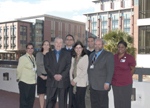|
|
|

|
Biomedical imaging gets competitive edge
|
by Cindy Abole
Public Relations
Biomedical imaging will rise to the next level
as MUSC applies new technologies that focus on the needs of the
research community while tapping the talents of a team of
scientists.
MUSC leadership and statewide collaborators believe this new
imaging-based biomedical research initiative has the potential to
someday rank among the best in the nation.
 Among MUSC’s new
imaging faculty recruited in 2010 include Dr. Fatima Falagola, Dr.
Ali Tabesh, Dr. Saeid Tajeri, Dr. Etta Pisano,
Elodia Cole, Dr. Joseph Helpern, Dr. Truman Brown and Dr. Jane Joseph.
Not pictured are Drs. D.J. Connor and Colleen Hanlon. Among MUSC’s new
imaging faculty recruited in 2010 include Dr. Fatima Falagola, Dr.
Ali Tabesh, Dr. Saeid Tajeri, Dr. Etta Pisano,
Elodia Cole, Dr. Joseph Helpern, Dr. Truman Brown and Dr. Jane Joseph.
Not pictured are Drs. D.J. Connor and Colleen Hanlon.
In fall 2010, the MUSC board of trustees approved a university center
designation for the new Center for Biomedical Imaging (CBI). The CBI
will be headed by Joseph A. Helpern, Ph.D., one of the South Carolina
Centers of Economic Excellence Endowed chairs in brain imaging
recruited to MUSC in late 2010.
A world-renowned imaging scientist and recipient of numerous awards,
patents, and National Institutes of Health (NIH) grant awards, Helpern
moved from New York University School of Medicine where he led similar
efforts as founding director of the Center for Biomedical Imaging.
Joining Helpern in guiding MUSC imaging research efforts is Truman R.
Brown, Ph.D., professor of radiology and director for the Center for
Advanced Imaging Research (CAIR). Brown, who was recruited from
Columbia University will serve as scientific director under the newly
formed CBI. Brown has several patents in magnetic resonance
spectroscopic imaging, which have helped advance the field especially
in the study of cancer.
Helpern, who also is vice chairman for research in radiology, has built
a career on enhancing imaging research and developing new applications
and technologies in this growing area of medicine. He was a pioneer in
the field of Magnetic Resonance Imaging since its beginnings in the
late 1970s and helped build the first version of what is now considered
a clinical 3 Tesla MRI system. Helpern and Brown have previous
experience establishing several imaging research centers around the
country. Helpern was originally contacted by MUSC leadership in 2006,
but the timing was not right.
Helpern said, “MUSC already had an incredible amount of quality imaging
equipment within the Department of Radiology— a 3 Tesla MRI, PET, CT
and other specialty MRI machines—but lacked an experienced community of
imaging specialists to support this effort. Since then, we’ve focused
on what was needed to take imaging at MUSC to the next level.”
To help establish a critical mass of experts on campus, both Helpern
and Brown have been busy recruiting imaging scientists while enriching
the Department of Radiology’s NIH research grant portfolio.
Already, the program has recruited eight imaging research faculty who
have brought along more than $3 million in research funding.
As director of the CBI, Helpern will report directly to Etta Pisano,
M.D., dean of the College of Medicine and vice president of medical
affairs. Pisano is an internationally recognized breast imaging
radiologist and translational researcher. “The clinical and research
applications for biomedical imaging have seen unprecedented growth
during the past three decades.”
Helpern is meeting with basic scientists and imaging science colleagues
on campus and researchers across South Carolina. He’ll promote CBI’s
biomedical imaging capabilities and communicate the CBI’s mission to
serve as a centralized facility and resource providing opportunities
for basic and clinical scientists to collaborate and discover new ways
to study diseases and disease processes and to translate these advances
to the patient community.
Phillip Costello, M.D., chairman of the Department of Radiology and
Radiological Science, said “Dr. Helpern will be a great colleague and
mentor to our research scientists who have an interest in medical
imaging.”
Helpern will be establishing a CBI strategic planning committee
consisting of leaders in the field of imaging at MUSC and will be
working to set in place the necessary foundation for a projected
opening on July 1. He also plans to identify and share other statewide
imaging resources.
Both Helpern and Brown have defined CBI’s biomedical imaging technology
to include magnetic resonance imaging, PET, CT and optical imaging.
These technologies can be used to image cells in the study of breast
cancer, cardiovascular disease, musculoskeletal disorders, Alzheimer’s
disease, drug addiction, ADHD, autism and many other important
diseases. Several of the new imaging faculty will have a presence in
the new bioengineering building slated to open later in 2011.
Helpern said there’s a support network for imaging research that is
important. “No one can develop ideas and write grants on their
own. This group’s presence on campus, plus the interactions with other
campuswide faculty, will help cross fertilize our ideas and help them
grow into funded research projects. Imaging research can be applied to
many areas of medicine including neuroscience, psychiatry,
rehabilitative medicine and bioengineering,” he said.
Asked what best promotes MUSC’s growth in medical imaging Helpern said
it’s a matter of changing expectations.
“I think our biggest barrier or challenge is ourselves,” Helpern said.
“We need to shoot for the stars in this effort and let others look at
MUSC’s biomedical imaging expertise and statewide commitment with envy.
We have creative, bright and hard working people who can get things
done. All of the ingredients for success are here. We just need to
believe and challenge ourselves to move forward to achieve success. “
For More Info:
Visit http://clinicaldepartments.musc.edu/radiology/research.htm
Friday, Jan. 14,
2011
|
|
|



